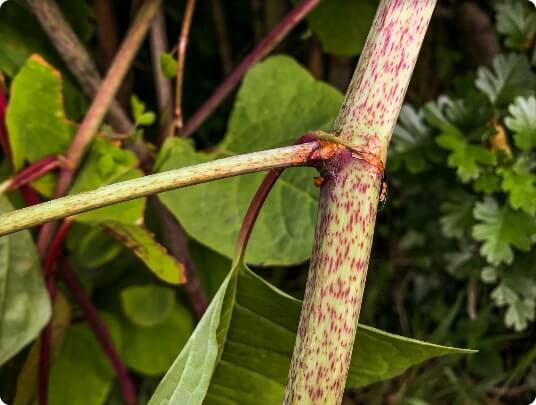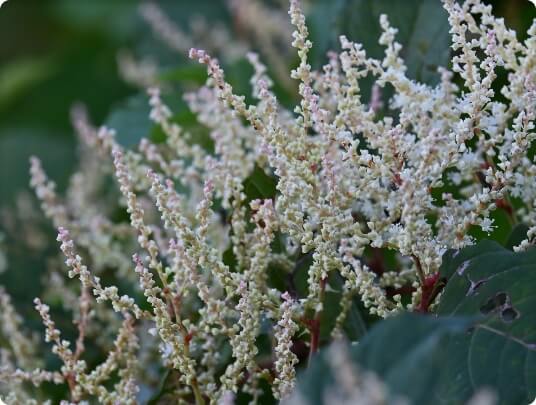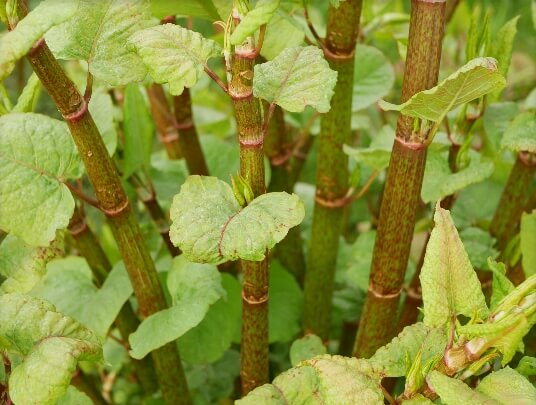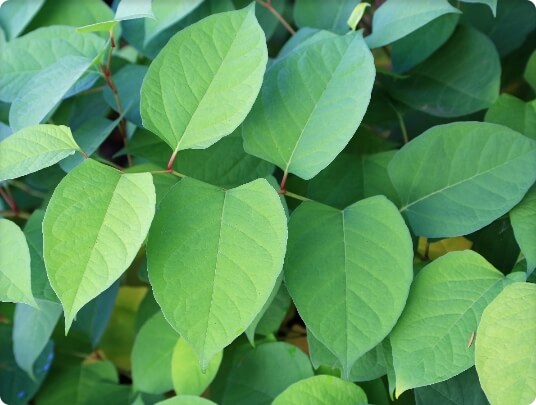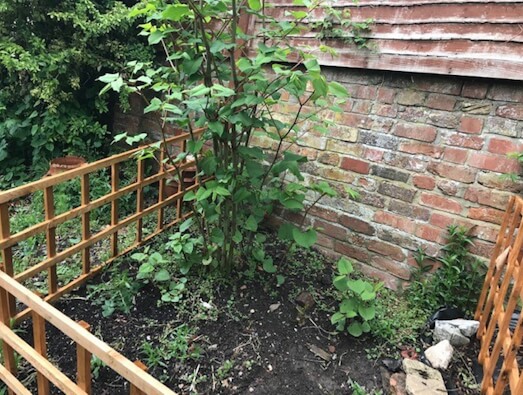How to Identify Japanese Knotweed:
Identifying Japanese Knotweed Stems
Japanese knotweed stems are pretty distinctive, which can be very helpful with knotweed identification. Japanese knotweed stems can grow over 2 metres tall, and their dense hollow stems are similar to - and are sometimes mistaken for - bamboo!
The base of the stems can be quite thick, around 5cm in diameter, and the hollow stems are pretty fragile and can snap fairly easily.
Knotweed stems are typically green and purple in colour. In the winter, they die back and become a reddish-brown colour.
The base of the stems can be quite thick, around 5cm in diameter, and the hollow stems are pretty fragile and can snap fairly easily.
Knotweed stems are typically green and purple in colour. In the winter, they die back and become a reddish-brown colour.
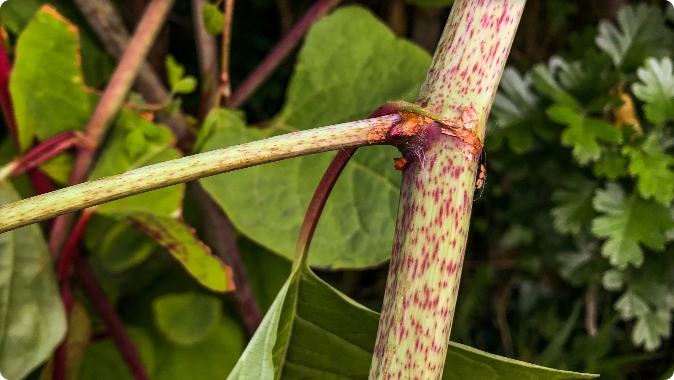
Identifying Japanese Knotweed Roots
Japanese knotweed is well known for its extensive rhizome system; in fact, it’s the very feature that makes knotweed such a troublesome weed to remove.
The outside of the root is a dark brown colour, and if you cut into a knotweed root, you will see the orange flesh inside.
The size of the roots can vary depending on the size and age of the plant. The crown is the largest part of the root and can grow up to 40cm in diameter.
The outside of the root is a dark brown colour, and if you cut into a knotweed root, you will see the orange flesh inside.
The size of the roots can vary depending on the size and age of the plant. The crown is the largest part of the root and can grow up to 40cm in diameter.
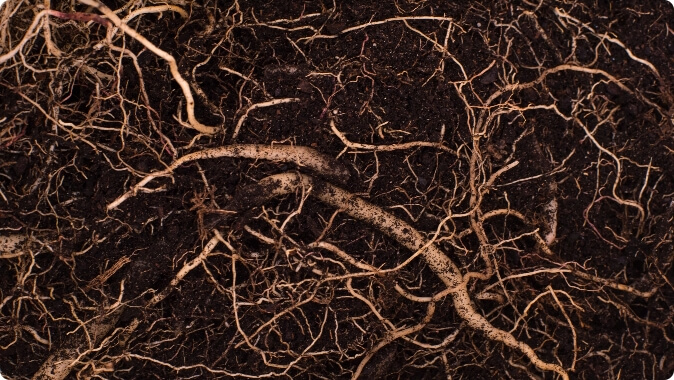
Identifying Japanese Knotweed Flowers
Japanese knotweed typically flowers in the summer and early autumn, with blooms of petite creamy-white flowers growing in clusters up to 10cm long. The flowers usually last through to October, dying down at the end of autumn as winter begins.
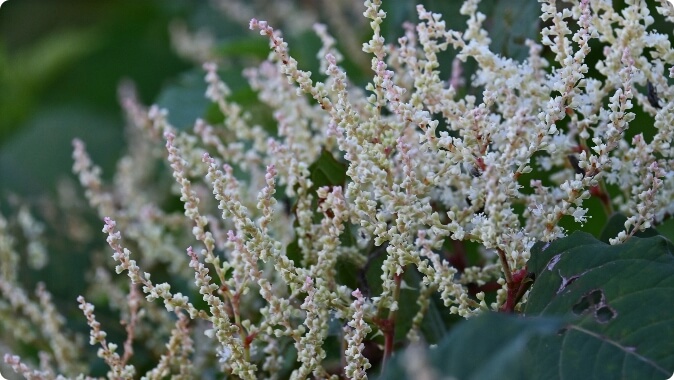
Identifying Japanese Knotweed Leaves
Japanese knotweed leaves are present for a most of the year, save for winter. When knotweed leaves first grow in the spring, they are a purplish burgundy colour. They are rolled up tightly to the stem, looking similar to an asparagus tip. As the leaves begin to mature, they will unfurl and their colouring becomes a deeper green. The final form of the knotweed leaf is a vibrant green that is often described as being shaped like a heart or a shovel, ranging from 10-20cm in length.
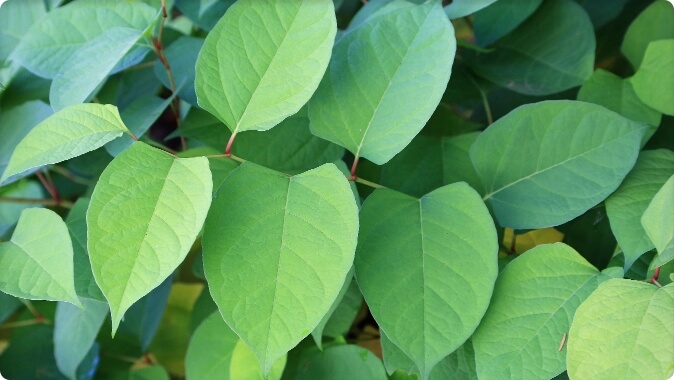
Identify Japanese Knotweed Through the Seasons
Japanese knotweed is an herbaceous perennial, meaning that it dies down to the ground during the winter and sends up new top growth every year. As such, knotweed looks different throughout the seasons.
This can make knotweed hard to identify at different times of year, so we’ve put together a handy guide to help you identify Japanese Knotweed by season.
This can make knotweed hard to identify at different times of year, so we’ve put together a handy guide to help you identify Japanese Knotweed by season.
Japanese Knotweed Identification in Spring
So, what does knotweed look like in spring? After dying down in the winter, spring is the season when knotweed starts to regrow. Around mid-March time, red and purple shoots will start to emerge, quickly growing into purplish shoots and unfurling leaves.

Japanese Knotweed Identification in Summer
In the summer, Japanese knotweed takes on some of the physical features that it is best known for. By this time, the leaves will have completely unfurled and taken on a bright green colour. The green and purple shoots will grow tall, possibly even over 2 metres, and the tell-tale while flowers will start to grown in clusters.

Japanese Knotweed Identification in Autumn
As summer gives way to autumn - like most seasonal plants - knotweed also submits to the seasonal shades of gold. The heart-shaped leaves turn yellow, and the stems will also fade from green to a darker brown. As we reach the end of autumn, the plant will start dying down in preparation for winter.

Japanese Knotweed Identification in Winter
In the winter, Japanese knotweed can be pretty hard to identify as it loses a lot of its colouring and dies down to the ground. The leaves and flowers completely retreat, leaving just the bare brown stalks jutting from the ground.

Japanese Knotweed Pictures
They say a picture is worth a thousand words, so we’ve put together a Japanese knotweed gallery to help you get a better idea as to whether the mysterious new weed on your property is Japanese knotweed or something else entirely.
If you're seeing something similar to the pictures below but still aren't sure whether it's Japanese knotweed or something else, reach out and contact us today. A member of our team will be more than happy to answer any questions you have and help you arrange your FREE SURVEY.
Free SurveyIf you're seeing something similar to the pictures below but still aren't sure whether it's Japanese knotweed or something else, reach out and contact us today. A member of our team will be more than happy to answer any questions you have and help you arrange your FREE SURVEY.
